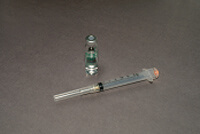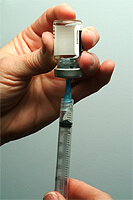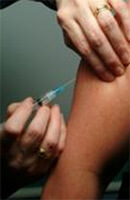Giving An Injection
Your doctor has prescribed medicine that is available as an injection (shot). The medicine is given as a subcutaneous or intramuscular injection. Subcutaneous means the medicine is given into the fatty tissue under the skin. Intramuscular means the medicine is given into the muscle. The needle used to give the injection is very small. Your doctor will prescribe the amount and time you need to give the medicine. Your doctor or nurse will also show you how to give an injection before you need to give one at home. Please talk with your doctor or nurse if you have any questions or concerns.
Storing the Medicine
- Check the package insert for how to store the medicine.
- Do not use the medicine past the expiration date.
Gathering Your Supplies
Gather your supplies. Place them on a clean surface near you.
The supplies you will need for each injection include:
- Vial of Medicine
- Syringe with a needle
- Alcohol wipes
- Cotton balls
- Band aides (if needed)
- Puncture proof container for used needles and syringes (hard plastic milk container with a screw on cap)
- Written record
Preparing the Solution
- Wash your hands prior to preparing the solution.
 Check the label on the vial of medicine. Make sure you have the right medicine. Check the expiration date. Do not use the medicine if the expiration date has passed.
Check the label on the vial of medicine. Make sure you have the right medicine. Check the expiration date. Do not use the medicine if the expiration date has passed.- Remove the plastic cover from the vial of medicine. You will not replace this plastic cover. You will see a rubber stopper. Wipe the top of the vial with an alcohol swab.
- Hold the syringe. Pull off the needle cover with your other hand. Do not touch the needle or lay the syringe down when the needle is uncovered.
- Pull back the end of the plunger to the dose of medicine you will be taking.
- Invert the vial of medicine, so the rubber stopper is facing down.
- Insert the needle into the inverted vial. Make sure the needle is close to the rubber stopper, but inside the vial. Push the plunger so the air in the syringe goes into the vial.
 Now, pull back on the syringe plunger to pull the right amount of solution from the inverted vial into the syringe.
Now, pull back on the syringe plunger to pull the right amount of solution from the inverted vial into the syringe.- Take the needle out of the vial.
- Check for air bubbles in the syringe. Gently tap the syringe with the needle up. This will cause the air bubbles to rise to the needle end of the syringe slowly. Push the plunger, and air will leave the syringe.
- Your doctor has prescribed the correct dose of medicine for you. Check to make sure you have the right amount of medicine. The injection is now ready.
Preparing the Site
The injection is given in the arm (by someone else), leg or stomach. Choose a site that is not red, swollen or bruised. Your healthcare provider will review the best sites to give the injection.
Once the site is selected cleanse the site with an alcohol swab. Begin at the center and clean the skin in a circular outward motion. Allow the alcohol to dry before giving the injection.
Giving the Injection
 Check again to make sure you have the right amount of medicine.
Check again to make sure you have the right amount of medicine.- Hold the syringe in the hand you write with like a pencil or dart.
- With your other hand, pinch the skin between the thumb and index finger.
- Insert the needle quickly into the pinched skin at a 45° (slight angle for subcutaneous) or 90° (straight for intramuscular). Your healthcare provider will show you the best position.
- After the needle is completely inserted, release the skin that you pinched.
- With the free hand, pull back slightly on the plunger. If blood appears in the syringe, remove the needle. Start at step 1, Giving the Injection, with a new needle.
- If no blood appears, push the plunger slowly to inject the medicine.
- Once the medicine is injected, remove the needle.
- Press a cotton swab over the injection site for several seconds. Apply a band aide.
- Do not recap the needle. Dispose of the needle and syringe in the puncture proof container.
Recording the Injection
Keep a record of the date, time and the site you use for the injection. Also keep a record of any reaction you may have had. If you think you may have had a reaction, contact your healthcare provider.
Download a Record for Medicine Injection chart (pdf).
This information has been approved by Ann Mullen, RN, CNS, MSN, AE-C (July, 2013).
